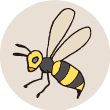 Make a mountaineering plan
Make a mountaineering plan
Make sure to create a mountaineering plan before mountaineering. The time of departure, the approach and the means of transportation, the point of entry, the route, the destination (reservation for a hotel if staying), and the course time should be researched in advance to be reflected on a schedule. Beginners or people who are not confident in their stamina should especially plan a schedule with enough time to spare.
Form a list of gears, equipment and baggage in advance as well. You must not forget an emergency management plan with an evacuation route for bad weather or food supplies, etc.
 Improve your map reading skills
Improve your map reading skills
The most common reason for getting lost in the mountains is losing the path. There are factors that could get you lost even in a low mountain, such as a woodland trail that blinds your view, or game trails that intersect your path. Though maps are mandatory for mountaineering, it is useless if you lack the skills to interpret the map. It is important to understand basic map symbols.
Meanwhile, you must learn how to use a compass. It will help you to find the direction of your destination and/or current location, as well as to understand where a distant location can be found on a map.
 Pay attention to sudden changes in the climate
Pay attention to sudden changes in the climate
The mountain climate changes easily. Completely losing your sight due to an unexpected shroud of mist, and encountering sudden heavy rainfall, thunder and/or strong wind are not rare events. As climate changes often occur in the afternoon, the foundation of mountaineering is to start at an early hour, and start climbing down just after noon.
 Wear a lifejacket
Wear a lifejacket
Just in case, wearing a lifejacket is recommended for mountaineering near rivers, as there may be sudden strong currents and, unlike ocean water, it is difficult to float in fresh water.
 Watch out for your physical condition
Watch out for your physical condition
Changes in the environment can cause physical deterioration. Getting a heatstroke / sunstroke, hypothermia, altitude sickness (hypoxia), food poisoning, etc. is common during mountaineering.
To prevent a heatstroke / sunstroke, it is important to avoid long exposure to the hot sun and stay well hydrated with fluids and (saline) minerals.
Hypothermia is caused by the lack of protection from the cold. When your body temperature drops, your decision making and physical mobility decreases, leading to suffering from a lower level of consciousness and putting you in a dangerous situation. Wet clothes should be changed frequently, and protection from the cold should not be neglected, even during the summer.
Food poisoning is especially common during the summer. Your lunchbox, etc. must be handled with care.
 Avoid acting alone
Avoid acting alone
Mountaineering requires decision making in various situations such as changes in the weather or your physical condition; therefore, the primary rule is to “avoid acting alone.” Especially for beginners, there is a higher risk of being injured and/or becoming lost, so mountaineering with experienced hikers is recommended. There are also hiking tours that beginners can join.
Even when hiking in a pair, if one becomes unable to move, you will have to act alone when calling for help; therefore, it is safer to hike with a group of 3~4, including (an) experienced hiker(s).
 Stress-free mountaineering / hiking
Stress-free mountaineering / hiking
For hiking, the general way to walk is lifting your knees to avoid tripping over rocks or tree roots. You should take small steps, land your feet flat on the ground, and use your whole body. Using trekking poles will ease the burden on your walk. When mountaineering, walking with your feet facing outwards will reduce the strain on your ankles.
 Dangerous locations
Dangerous locations
On mountaineering maps, there are locations with hidden dangers that are not written on the map.
On a rough slope full of stones and rocks, you need to watch out for loose rocks. Stepping on these rocks without realizing it may cause the rocks to slide, leading to a fall or an injury. Also, if you encounter falling rocks or cause a rockfall, please let people around you know with a big voice. It is important to move along conscious of what is under your feet and above your head.
 Animals and plants to be aware of, and how to respond
Animals and plants to be aware of, and how to respond
There are dangerous animals and plants in the mountain. It is an iron rule “not to get close or touch them carelessly;” however, if you are unluckily harmed by them, it is important to handle the situation calmly. To prevent any contact, long sleeve shirts, long pants and gloves should be worn during all seasons.

If you are stung by a hornet (vespinae)
First, please move away from the hive immediately. While squeezing out the venom, wash your wound with clean water, use antihistamines or steroid cream, then go to an emergency hospital immediately.

If you are bitten by a venomous snake
If a venomous snake bites you, please calm down as much as possible. Wash your wound, sterilize it, keep your affected area above your heart, and immediately go to an emergency hospital.

Poison ivy (Toxicodendron orientale)
Out of many plants, poison ivy is especially toxic. Contact will cause itchy rashes, but it may take 1~2 days for the symptoms to arise. If symptoms appear, please see the dermatologist right away.

Wild boar
If you see a boar, do not get close. If you encounter a boar, maintain eye contact while walking away slowly and quietly, and wait until they walk away. Threatening them with a loud voice or scaring them could cause them to charge at you. It is especially dangerous if they are with their young.
 Have the courage to turn back
Have the courage to turn back
Pushing yourself to continue climbing thinking “we’re almost at the summit” or “but we already came this far” could result in serious trouble. It is important to have the courage to make the decision to turn back.
 Actions to take in an emergency ~injury~
Actions to take in an emergency ~injury~
To be prepared for “what if” situations, be aware of what actions to take when injured and confirm the necessary first aid kits in advance
For a sprain, cool down the injured area with a wet towel, and tape the area tightly.
For cuts / scratches, wash the area with clean water, sterilize it and stop the bleeding with a clean gauze.
For cuts on the back of your ankle (shoe sores), tape / cover the area; it is important to prevent it from becoming a blister.
The first-aid action for a broken bone is to return the bone to its original position, immobilize it, and then cool down the area. After completing the first-aid steps, immediately climb down or request a rescue.
 Actions to take in an emergency ~getting lost~
Actions to take in an emergency ~getting lost~
Thinking “I am OK” or “nothing can go wrong in a low mountain” is what causes you to get lost. While taking appropriate preparations and measures to prevent getting lost, please keep in mind the following procedures.
The first thing to do when lost is to calm down. Panicking can cause people to take dangerous actions that they would not take in a normal state.
Even for a single day of mountaineering, you will be able to reset your feelings if you come prepared for an emergency night walk or bivouac. Knowing that you can stay overnight will give you more time to think of a resolution. It is also important to submit the hiking registration form and tell your mountaineering schedule to your family and friends.



